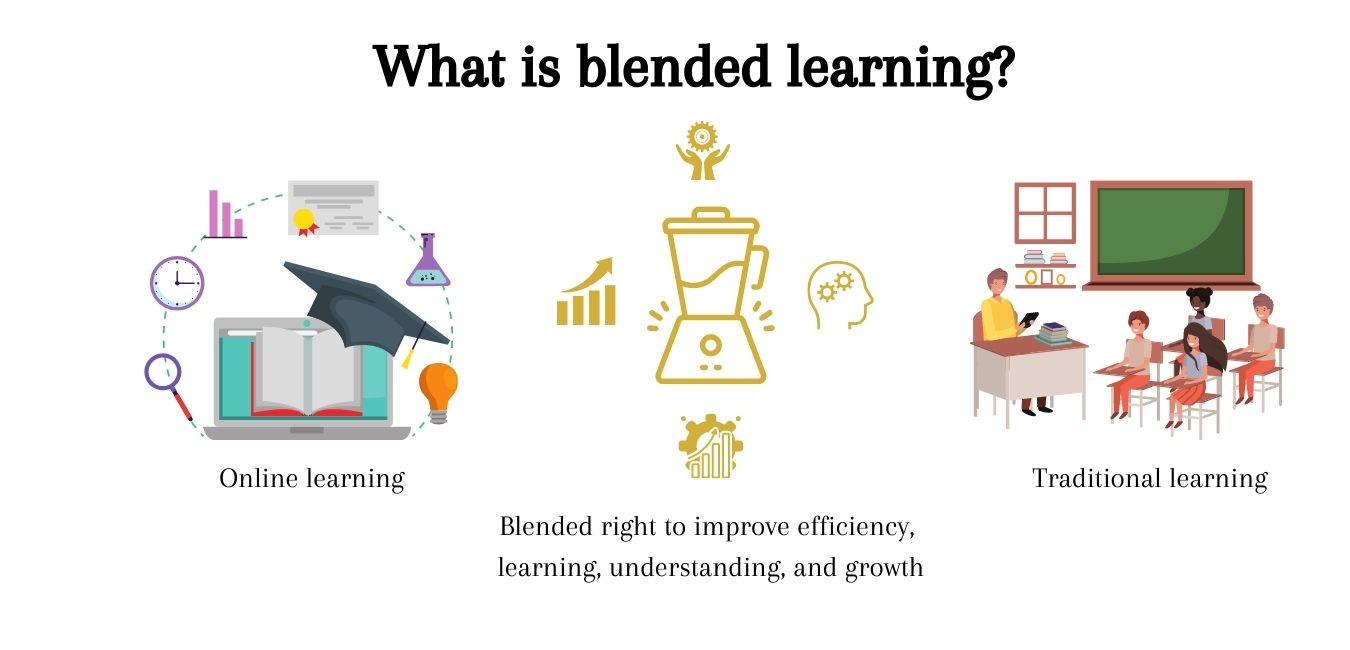
Table of Content:
1. Introduction
2. What is blended learning?
3. A 3 distinct blended learning models- commonly used
4. Why Blended learning?
When you study in the classroom with a group of students, you might sometimes not understand what your classmates understood at once. Ever wondered why? Well, everyone does not have the same pace of understanding. Some learners may understand better with a specific technique or method while others require different methods of learning. In this changing time of the modern world, the traditional ‘classroom-only’ approach is transforming into technology-driven learning. Not to forget that both the approaches have their own pros and cons. Relying completely on only offline method or just online method of learning may not give the desired results. What if there is an approach where you can get to choose a mix of both? Yes, you read it right! Blended learning aims to enhances the elements of both offline and online education methods to ensure efficient learning.
What is blended learning?
Blended learning is an approach to education which uses the combination of traditional face-to-face learning experiences with online and mobile technologies. It aims in combining online educational materials and opportunities with the traditional based classroom materials. Blended learning has resulted in higher achievement of students when compared to either fully online or fully face-to-face learning experiences. In the past decade, educational institutions have organically adopted blended learning.
The covid-19 situation and its outcome have hit every sector significantly, including the education sector. Diverse challenges are being faced in these tough times. This has forced us to find and adopt methods that help us keep going.
For the education sector, this crisis has opened gates for opportunities for the incorporation of digital methods. This is where we face the need of an approach that contributes to the continuation of quality education. Blended learning is one such key that opens the gate for the learners. Well, before we adapt this approach of education, we must understand how it works.
Check out our Blog on Game based learning and why is it important in 2021?
There are various ways to implement blended learning. Using a combination of one or more models can be used as dimensions of larger blended learning strategy. Below explained are some of the commonly used models from the distinct blended learning models.
1.Rotation model of learning-
In rotation model of learning consists, the time schedule is fixed and divided between the traditional face-to-face learning with online learning. This model includes four sub-models:
i) Station rotation:
This model allows students to rotate at fixed schedule from one online station to another, where one of the stations is an online station.
ii) Lab-rotation:
Just like the station rotation, lab rotation model enables students to rotate at fixed schedule. However, in this model the online learning takes place in a brick-and-mortar computer lab.
iii) Flipped-classroom model:
Online learning is the primary source in this model. Online resources are accessed for the content to be taught the next day.
iv) Individual-rotation model:
Individual schedules are set by the teacher for students for rotation. In this model, student rotates only on the scheduled station and therefore does not have the need to rotate on all the stations.
- Flex model of learning-
This model is for the non-traditional learners, for whom teachers are available for face-to-face consultation and guidance. The curriculum is delivered to the students via a digital platform. This model focuses on providing flexibility.
3. Self-blended model of learning-
This model is usually approached by the students who choose to take online courses in addition to the time they spend in traditional courses.
Why Blended learning?
Read on to learn more about the benefits of blended learning and its various models.
Flexible Blended Learning Strategy
It allows learners to choose what they prefer, whether learn with the familiar traditional classroom, or would rather learn online, or try a mixture of both. It takes every learner into account and utilizes a variety of methodologies.
Learning trends and technologies
Since blended learning uses both online and offline technologies, it enables the learners to be aware of the latest trends and helps them learn the technologies. The learners don’t just watch or listen but also “do it on their own” which ensures that they are applying the knowledge that they have gained.
Time and cost efficient
Blended learning cuts the time and cost of travelling. This gives the opportunity to improve the training costs.
Access Anywhere, Anytime
The learners can constantly connect from their devices. They can even download the content for later and watch it as many times as they want. This gives better understanding to as they can go back to the courses whenever they want.
Track of learner’s progress
With the help of tracking the report of the learner, trainers can get the insightful report. This helps to analyse where the learner is struggling and can they excel.
Enhances teaching efforts
Since the teacher uses unique methods after understanding the cognitive level and requirements of the learner, it enhances the teaching efforts. The teacher gets to use various techniques, methods and tools while teaching.
Covid-19 has made us realise the importance of integrated leaning. With this approach, a practical and convenient learning experience is ensured.
According to the results of a survey, 88% of learners globally say online learning will be a permanent part of primary, secondary and higher education. This opportunity called “blended learning” is going to be the new normal for the education sector. Moving forward, even when the situation gets normal (covid free), online learning is going to be a part of education as it has managed to highlight the benefits and convenience attached for both learners as well as the teachers. Irrespective of the fact that whether it is education industry or the corporate industry, the opportunities and benefits of using this concept are huge Measures like blended learning must be included as a definite part in the education system and we must give technology the importance that it deserves. So many tasks become easier, less expensive and more accessible to a wide range of learners. Life is unpredictable and this pandemic is the most relevant example for us to understand this. Thus, we should be prepared to survive, fight and find ways that keep us going. I hope this information will give you a better picture of blended learning! Don’t let your learning get restricted.





